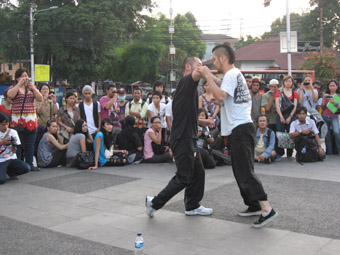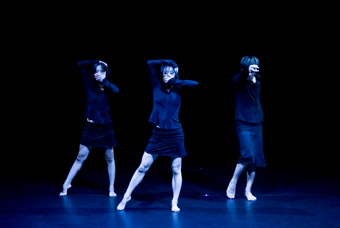 |
contact Gonzo, Public Space photo Phalla San |
This work was one of the two international offerings that contributed to the youthful exuberance of the 10th Indonesian Dance Festival. The other was Korean Kim Jae Duk's Darkness Poomba, bombarding the senses with a fusillade of fast movement combined with loudly belted lyrics and a beat that had the audience swaying and clapping.
Equally engaging, the two performances could not have been more different in execution and philosophy. Contact Gonzo doesn’t employ many theatrical tricks for its street performance, just the performers, an unamplified drum kit and simple props—water bottles, caps and disposable cameras. Although part of a dance festival, the physical language used cannot be comfortably labeled; it more closely resembles sport than dance in its raw action and response. In contrast, Darkness Poomba employed a full range of theatrical devices; strong lighting states to highlight the action, sleek costuming to show off the dancers’ physiques, sound amplification and a self-conscious breaking of the spectator-audience divide.
Kim's youthful energy as performer, composer and choreographer, drives the piece, particularly when he commandeers the microphone showing off his strong voice or plays soulfully on his harmonica. Self-described as 70% choreography and 30% music Darkness Poomba is both rock concert and contemporary dance performance, crafted to get the blood pumping and body bouncing. This is a “re-mix” of Korean Poomba music, a throw-back to when the country was impoverished and street singers roamed around to entertain in exchange for food and money, singing the meaningless but rhythmic word “Poomba."
 |
Darkness Poomba photo Phalla San |
Towards the end of the work the initial male pair re-appear moving metal dinner trays and bowls around with quick, concise movements and playing them as percussive accompaniment. Then like savage dogs they tear into imagined food, their beggarly appearance and hunger a reference to the history of Poombas.
The evocative, gestural movement vocabulary of the two sets them apart from the rest of the company, as Kim's choreography for the black-clad dancers is a cross of liquid, contemporary movement and the aggressive energy of hip hop, that demonstrates strong ballet training without using a balletic vocabulary. The dancers are all long legs with broken torso lines and body distorting gestures that sharply accent the music and punctuate the strong beat.
Their figures perfectly synchronised, the dancers move as precisely as a well oiled machine. Bombarding the audience with speed of movement that denied emotional engagement, the physical prowess of the performers was admittedly inspiring. One male jumped high, smashing his leg into the air and completing a full revolution before landing, but did this stunt serve any other purpose than to wow the audience? The choreography was kinesthetically pleasing but not emotionally engaging.
It was the music that carried emotional resonance, particularly in the hoarse cries that emanated from the singer. This took on a life of its own as it travelled around the theatre, originating in one corner of the stage then moving to another, blaring and retreating like an auditory game of hide and seek. Later in the the work, a drummer sat centrestage, two guitarists flanked the stage and three dancers ran into the auditorium. They appeared to be escaping audience scrutiny but actually carried it with them, enlarging the performance space, if taking focus off the dancers remaining on stage.
One particularly powerful moment involving the pair of floppy-haired Poombas highlighted the challenge to the confines of the space. They threw themselves to sprawl flat against a side wall and then slowly peeled off. This was an undeveloped, token exploration of the space, part of an apparent mish-mash of images and ideas. However, in the spirit of entertainment that comes with Poomba, every moment was crafted to please, as when all action came to a stand-still and the drummer had his moment in the spotlight with a vibrant solo.
Contact Gonzo takes similar advantage of the power of energetic rhythm. From the first clang of the cymbals, the drummer is a dynamo of energy, going to war with the drum set. Echoing this aggression the dancers actually trade slaps, the smacking sound they create making the audience wince.
Aptly named after a style of journalism that is part fiction, part fact, in their performed battles Contact Gonzo negotiate a fine line between play and reality. Looking like young lion cubs in a mock hunt, they balance between careful control and risky stunts. With little formal dance training to share between them there is no polished technique, but a primal language of expression emerging from their improvised performances, making the action raw and naked. The construction of the movement revolves around the vigilance of the performers, highlighting the image of the hunt as they circle each other or attack with a sudden lunge or a slap only to be countered with paw-like swipes.
By conventional standards this performance may not be considered aesthetically pleasing, but like the journalistic style it is named after, it favours gritty delivery over polished accuracy. And the fact that this could escalate to violence at any minute makes it riveting. The unpredictability manifests in many ways, a randomly thrown bottle, water splashing around or the appearance of a disposable camera. At one point they give the camera to a group of watching boys and pose. The overlap of the two groups (performers and spectators) makes a touching picture when juxtaposed with playful violence.
Finally the drumming builds to a climax, forcing the dancers to increase their level of physical engagement until with a final crash of the drums the actionl freezes, and although the dancers still eye each other, alert and on their toes, the performance is over by common consensus as the audience breaks into applause. Contact Gonzo's Yuya Tsukahara may have deliberately rebelled against theatrical conventions, but like Kim his focus is on involving the audience.
Here are two shows that travel very different paths to the same outcome: one taking full advantage of the effects a theatre offers, the other peeling production back to minimum, yet both create an immediacy that turns observer into participant. The explosion of energy that comes from the speed, risk and bone jarring sounds that these artists produce evokes a visceral response in the audience body making these works inescapably engaging and affecting.
10th Indonesian Dance Festival: Kim Jae Duk Project, Darkness Poomba, choreographer, composer, dancer, musician Kim Jae Duk, with dancers and musicians; Graha Bhakti Sudaya, June 14; contact Gonzo and Sayaka Himeno, public space, Graha Bhakti Sudaya, Taman Ismail Marzuki, Jakarta, June 14
10 years ago Melissa Quek began her career as a contemporary dancer in Singapore. In addition to performing, she continues to contribute to the Singapore dance scene as a choreographer and teacher, and is currently Programme Coordinator for the BA(Hons) Dance Programme at LASALLE College of the Arts, Singapore.
© Melissa Quek; for permission to reproduce apply to [email protected]








 back
back